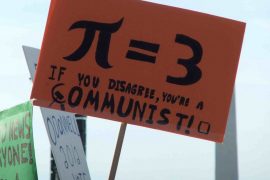A Math for Grownups follower asked me earlier this week to define algebra, and I thought that was an excellent place to start this month-long discussion. I think that most people might be surprised by what is generally found under the algebra tent. The basic definition is pretty broad:
Algebra is a branch of mathematics that uses letters and other symbols to represent numbers and quantities in formulas and equations. This system is based on a given set of axioms.
What does this mean? Well, it’s basically the step beyond arithmetic, where we only deal with numbers. Algebra allows us the flexibility of an unknown — the variable — so that we can make broader statements about situations.
Look at it this way: 8 + 3 is always 11. Always. But 8 + x depends on the value of x. This means we can pretty much substitute whatever we want for x. See? Flexibility. (Of course 8 + x has no meaning without some kind of context. But we’ll get to that later in the month.)
Algebra allows us to discover and create rules. These rules might be formulas or equations that describe a particular situation. Because of algebra, we know that the circumference of a circle is 2πr, where π is the number 3.14… and r is the radius of that circle.
Now, let’s take this definition one step further. What is the circumference of a circle with radius 1?
C = 2πr = 2π(1) = 2π
But what about the circumference of a circle with radius 2?
C = 2πr = 2π(2) = 4π
If you look closely at this, you can draw a conclusion: The larger the radius of a circle, the larger its circumference. When the radius is 1, the circumference is 2π; when the radius is twice as long, the circumference is twice as big.
This points to a critical aspect of algebra: relationships.
Algebra is a branch of mathematics that deals with general statements about the relationships between values, using numbers and variables to describe them.
The formula for the circumference of a circle is a description of the relationship between the circumference and the radius of any circle. When the radius changes, so does the circumference. When the circumference changes, so does the radius. (π is a constant, even though it is technically a Greek letter. Whenever you see π, you know you’re dealing with the number 3.14…)
So that’s it. Algebra is nothing more than a way to describe the relationships between values (numbers, measurements, etc.). In the example of circumference, we’re dealing with two branches of math. The geometry describes why the circumference is twice π times the radius. The algebra is how we describe that relationship in the form of a formula.
Without algebra, we really don’t have ways to describe many things about our lives — from geometry formulas to finding compound interest on a loan. We can fumble around and come to a conclusion, but in the end, algebra can make this process much simpler.
What do you think about these definitions of algebra? Does thinking about algebra in these ways make it a little less threatening? If so, how? Share your ideas in the comments section!
